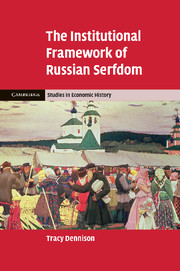Book contents
- Frontmatter
- Contents
- List of figures and tables
- Preface
- A note on the value of the rouble
- A note on transliteration
- List of abbreviations
- Glossary
- Map: Yaroslavl' and surrounding provinces
- 1 Why is Russia different? Culture, geography, institutions
- 2 Voshchazhnikovo: a microcosm of nineteenth-century Russia
- 3 Household structure and family economy
- 4 The rural commune
- 5 Land and property markets
- 6 Labour markets
- 7 Credit and savings
- 8 Retail markets and consumption
- 9 The institutional framework of Russian serfdom
- Bibliography
- Index
3 - Household structure and family economy
Published online by Cambridge University Press: 03 May 2011
- Frontmatter
- Contents
- List of figures and tables
- Preface
- A note on the value of the rouble
- A note on transliteration
- List of abbreviations
- Glossary
- Map: Yaroslavl' and surrounding provinces
- 1 Why is Russia different? Culture, geography, institutions
- 2 Voshchazhnikovo: a microcosm of nineteenth-century Russia
- 3 Household structure and family economy
- 4 The rural commune
- 5 Land and property markets
- 6 Labour markets
- 7 Credit and savings
- 8 Retail markets and consumption
- 9 The institutional framework of Russian serfdom
- Bibliography
- Index
Summary
The nature of the peasant household constitutes the most significant single characteristic of the peasantry as a specific social phenomenon and gives rise to the generic features displayed by peasantries all over the world. A peasant household is characterised by the extent of integration of the peasant family's life with its farming enterprise … A Russian peasant household consisted typically of blood-relatives spanning two or three generations and their spouses. However, the basic determinant of household membership was not the actual kinship but the total participation in the life of the household … This unity implied living together under the authority of the patriarchal head, close cooperation in day-to-day labour, a ‘common purse’, and the basic identification of a member with the household … Generally, the head of the household was the father of the family or its oldest male member. His authority over other members and over household affairs implied both autocratic rights and extensive duties of care and protection … Women, in spite of their heavy burden of labour, were … nearly always placed under the authority of a male … The scope of market and money relations was limited by the extent of the consumption-determined production, low rates of surplus, and a low level of professional specialisation and diversification of the rural population.
T. Shanin, Russia as a ‘developing society’ (New Haven and London, 1985), pp. 66–7.- Type
- Chapter
- Information
- The Institutional Framework of Russian Serfdom , pp. 50 - 92Publisher: Cambridge University PressPrint publication year: 2011



